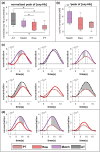Investigating the cortical effect of false positive feedback on motor learning in motor imagery based rehabilitative BCI training
- PMID: 40102969
- PMCID: PMC11916930
- DOI: 10.1186/s12984-025-01597-w
Investigating the cortical effect of false positive feedback on motor learning in motor imagery based rehabilitative BCI training
Abstract
Background: Motor imagery-based brain-computer interface (MI-BCI) is a promising solution for neurorehabilitation. Many studies proposed that reducing false positive (FP) feedback is crucial for inducing neural plasticity by BCI technology. However, the effect of FP feedback on cortical plasticity induction during MI-BCI training is yet to be investigated.
Objective: This study aims to validate the hypothesis that FP feedback affects the cortical plasticity of the user's MI during MI-BCI training by first comparing two different asynchronous MI-BCI paradigms (with and without FP feedback), and then comparing its effectiveness with that of conventional motor learning methods (passive and active training).
Methods: Twelve healthy volunteers and four patients with stroke participated in the study. We implemented two electroencephalogram-driven asynchronous MI-BCI systems with different feedback conditions. The feedback was provided by a hand exoskeleton robot performing hand open/close task. We assessed the hemodynamic responses in two different feedback conditions and compared them with two conventional motor learning methods using functional near-infrared spectroscopy with an event-related design. The cortical effects of FP feedback were analyzed in different paradigms, as well as in the same paradigm via statistical analysis.
Results: The MI-BCI without FP feedback paradigm induced higher cortical activation in MI, focusing on the contralateral motor area, compared to the paradigm with FP feedback. Additionally, within the same paradigm providing FP feedback, the task period immediately following FP feedback elicited a lower hemodynamic response in the channel located over the contralateral motor area compared to the MI-BCI paradigm without FP feedback (p = 0.021 for healthy people; p = 0.079 for people with stroke). In contrast, task trials where there was no FP feedback just before showed a higher hemodynamic response, similar to the MI-BCI paradigm without FP feedback (p = 0.099 for healthy people, p = 0.084 for people with stroke).
Conclusions: FP feedback reduced cortical activation for the users during MI-BCI training, suggesting a potential negative effect on cortical plasticity. Therefore, minimizing FP feedback may enhance the effectiveness of rehabilitative MI-BCI training by promoting stronger cortical activation and plasticity, particularly in the contralateral motor area.
Keywords: Brain–computer interfaces; Event-related design; Feedback; Motor imagery; Motor learning; Near-infrared spectroscopy.
© 2025. The Author(s).
Conflict of interest statement
Declarations. Ethics approval and consent to participate: All volunteers signed an informed consent approved by the Daegu Gyeongbuk Institute of Science and Technology IRB prior to the experiment (DGIST-170721-HR-025-08). Consent for publication: Not applicable. Competing interests: The authors declare no competing interests.
Figures








References
-
- Schaechter JD. Motor rehabilitation and brain plasticity after hemiparetic stroke. Prog Neurobiol. 2004;73(1):61–72. - PubMed
-
- James W. The principles of psychology; 1890.
-
- Jerzy, Konorski. Conditioned reflexes and neuron organization. CUP Archive; 1948.
-
- Wolpaw JR, Birbaumer N, McFarland DJ, Pfurtscheller G, Vaughan TM. Brain–computer interfaces for communication and control. Clin Neurophysiol. 2002;113(6):767–91. - PubMed
MeSH terms
Grants and funding
LinkOut - more resources
Full Text Sources
Medical

